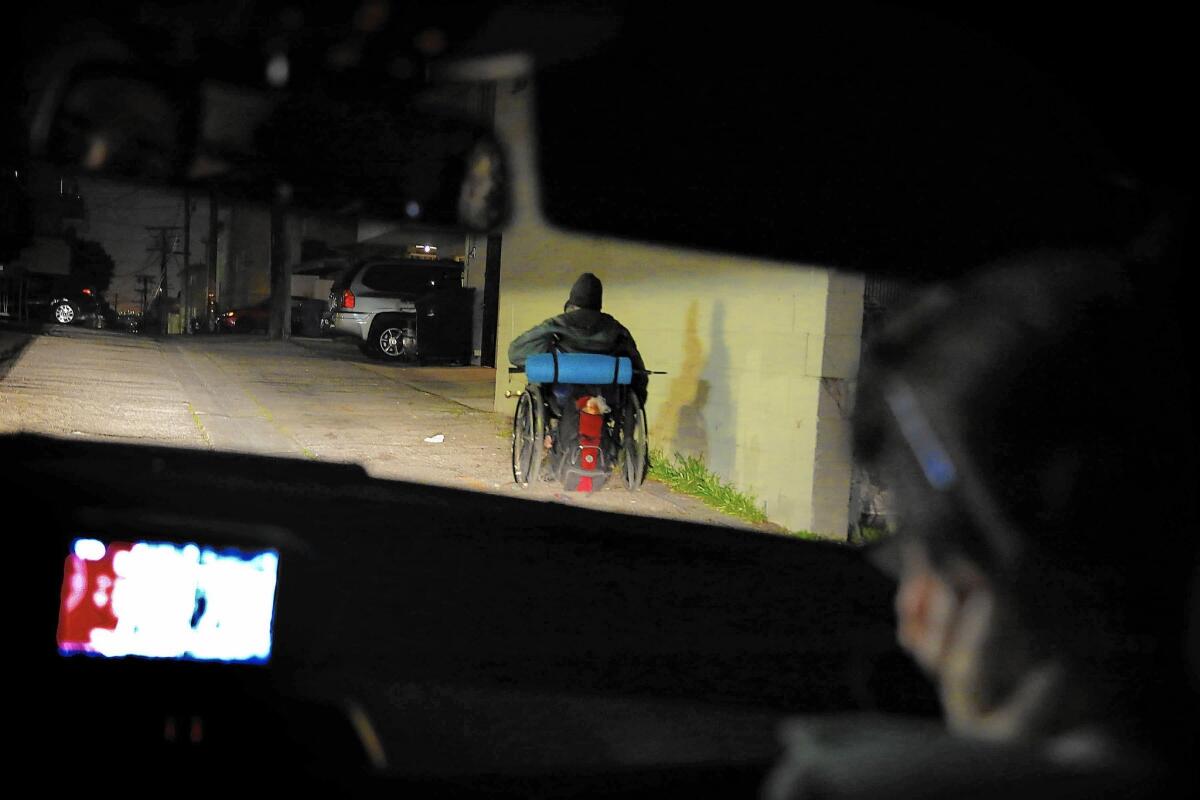Volunteers set out to count affluent Brentwood’s homeless

- Share via
The party was in full swing at the gleaming Cabo Cantina bar in Brentwood when Arya Hadidi spotted a woman pulling a laundry cart stuffed with cardboard and blankets across the street.
“There you go, we got one,” said the 17-year-old student. “Mark it up, Mom.”
Arya was part of a brigade of more than 4,000 volunteers who spread across the county over three days last week looking for tents and shopping carts during the county’s biennial homeless count.
He had no trouble grasping the essential sadness of the situation. “It’s tragic,” he said.
But growing up in affluent Brentwood, he was accustomed to seeing homeless people. When his anthropology teacher offered extra credit for joining the count, Arya headed for the Barrington Recreation Center to volunteer for Brentwood’s first-ever homeless tally, with his mother riding shotgun.
“I know where they’d be,” he said later. “If I was a homeless person, I’d go to rich neighborhoods too.”
The count, conducted by the Los Angeles Homeless Services Authority, provides a snapshot of how many people are homeless at a particular point in time. Some who live in shelters are added to the tally. A follow-up survey will gather more detailed information about the homeless population, such as age, gender and military background.
The county must perform the count to receive federal funding for homeless programs. Although the tally does not directly affect the size of the federal allocations, it influences policy and helps outreach workers, officials said.
“How are we going to get services to people in the Palisades if we don’t even know they’re there?” county Supervisor Sheila Kuehl said of Pacific Palisades, which also had its first count this year.
Community members are encouraged to run their own counts, which is how Michelle Bisnoff, a Brentwood resident and community volunteer, ended up handing out clipboards and tally sheets to more than 30 volunteers Wednesday night.
Arya, who said he’s spending his senior year of high school attending community college to improve his grades so he can go to a top university and become an investment banker, was one of the youngest volunteers.
Volunteers received training in how to spot homeless people, including a list of telltale characteristics — “weathered skin,” “poor hygiene,” “lots of stuff.” This being Los Angeles, the count was conducted on wheels.
The Hadidis’ drive took them past people walking their dogs, heading to yoga, or working out in glass storefronts on elliptical machines. A few men with heavily lined faces and bulky duffel bags crossed paths with people out on the town.
Volunteers were cautioned not to try to boost their statistics. But the hunt was on, and soon Arya was wheeling back around the Baskin-Robbins ice cream store, near where he saw the woman with the laundry cart, hoping for another sighting.
“This seems promising. Two shopping carts,” he said. On a vacant lot next to the ice cream shop, someone was lying on a bare mattress.
Across the lot, a homeless man pushing a wheelchair stopped and fumbled with something.
“He’s eating a burrito,” Arya said, then corrected himself. “No it’s [an ice cream] drumstick.”
Arya’s mother, Nisrin Hadidi, an Iranian immigrant, occasionally admonished him in Farsi about his driving.
“In my country, if there’s some homeless, the neighbors bring out food,” Hadidi, 53, said in English. “Here, I’m scared.”
On San Vicente Boulevard, a lone sleeping bag with someone inside was splayed out under an awning. “I used to buy shoes here when I was little,” Arya said.
Circling back and down an alley, they found the man with the drumstick now sitting in the wheelchair, glowering from the back corner of a carport.
The Hadidis reported 17 homeless people. Brentwood’s unofficial total was 70.
“Almost twice as many as I thought,” Bisnoff said. She attributed the high count to Brentwood’s proximity to freeways and hospitals — including the Veterans Affairs Department’s West Los Angeles Medical Center — and church feedings, not to its wealth.
“I pay a fortune in taxes, it’s shocking to me anyone could go hungry,” she said.
Bisnoff said the community wanted to help its homeless residents, particularly the veterans. Hundreds of people turned out for the recent funeral of a homeless poet who hung out for years by a local grocery store, she said.
“My Girl Scout troop was there singing; people were teary-eyed,” she said. “There’s a failure somewhere in the system.”
Twitter: @geholland
More to Read
Sign up for Essential California
The most important California stories and recommendations in your inbox every morning.
You may occasionally receive promotional content from the Los Angeles Times.











